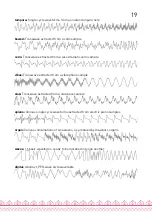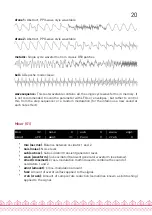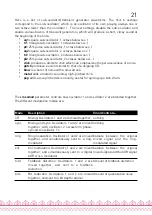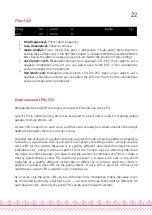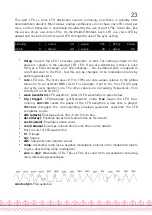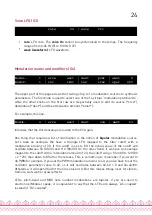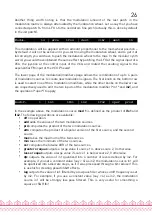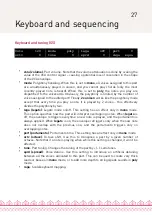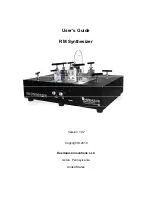
Besides this, it is up to you to route modulations to parameters. By default, the following
routings are wired:
Source
Destination
Amount
Env 1
Oscillator 1 parameter
0
Env 1
Oscillator 2 parameter
0
Lfo 1
Oscillator 1 pitch
0
Lfo 1
Oscillator 2 pitch
0
Lfo 2
Oscillator 1 parameter
0
Lfo 2
Oscillator 2 parameter
0
Lfo 3
Mixer balance
0
Lfo 4
Filter cutoff
0
Seq 1
Filter cutoff
0
Seq 2
Mixer balance
0
Envelope 3
VCA gain
100%
Velocity
VCA gain
25%
Pitch-bend
Oscillator 1+2 pitch
2 semitones
Lfo 4
Oscillator 1+2 fine pitch
2 semitones
Digital oscillators (S1)
Wave saw
| para 0
| rang 0
| tune 0
wave squa
| para 32
| rang -12
| tune 12
Each row displays the settings of an oscillator. The parameters are the following:
•
wave (waveform)
: Oscillator waveform family. Contrary to most synthesizers in
which waveforms are static, the Ambika waveforms are dynamic and can be
continously morphed — this is why it is more correct to refer to “waveform
families” instead of “waveforms”.
•
para (parameter)
: Morphing parameter. This morphs the selected waveform into
many variations.
•
rang (range)
: Oscillator pitch, from -36 semitones to 36 semitones (relative the
pitch of the MIDI note played on the keyboard).
•
tune (tune)
: Oscillator fine tune, from -0.5 semitone (-64) to 0.5 semitone (+64).
The following is a list of all the available waveform families, with some applications and a
description of what adjusting the
parameter
setting actually does.
13



















